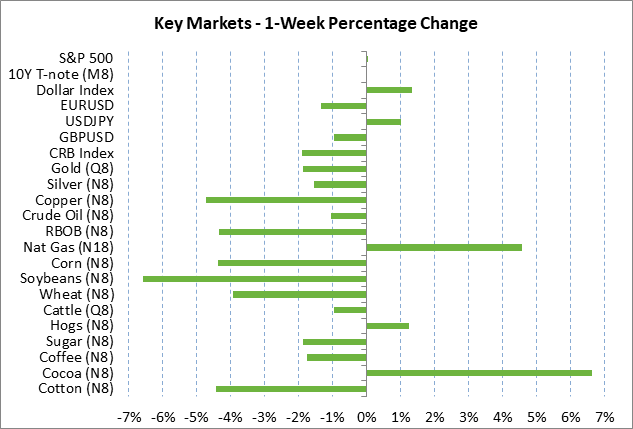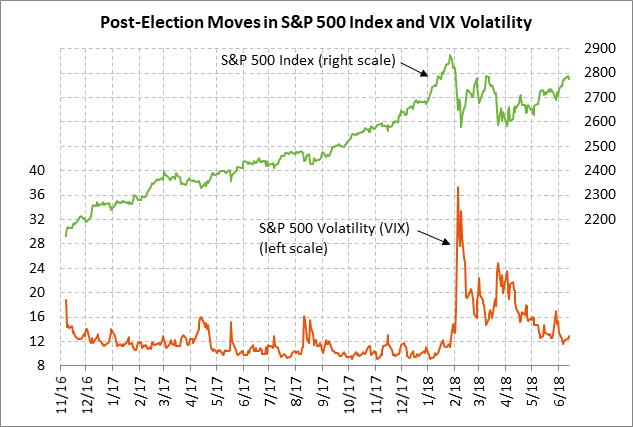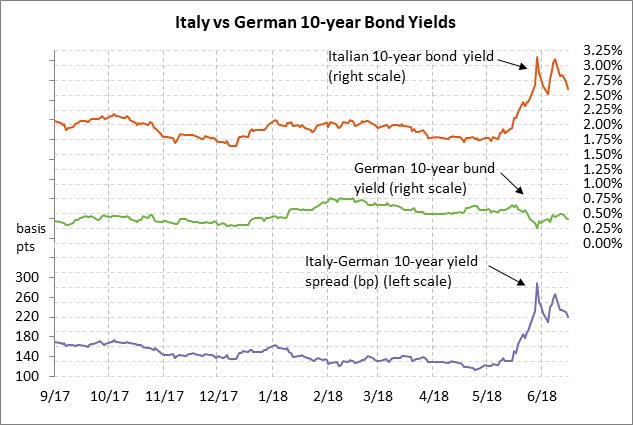- Weekly global market focus
- U.S. and China exchange first round of tariffs with the focus on whether there will be a second $100 billion round
- Merkel government is threatened by CSU revolt
- OPEC+ likely to boost production this Friday
Weekly global market focus — The U.S. markets this week will focus on (1) the U.S./Chinese trade war and whether it progresses beyond last Friday’s $50 billion round to another $100 billion round threatened by President Trump, (2) oil prices and whether OPEC+ at its 2-day meeting beginning this Friday increases production as expected, (3) a busy week of Fedspeak with the highlight being Fed Chair Powell’s appearance on Wednesday at a panel discussion at the ECB’s conference in Portugal, (4) the Treasury’s sale of $5 billion in 30-year TIPS on Thursday, and (5) another light earnings week with reports from ten of the S&P 500 companies (including FedEx and Oracle).
The European markets this week will focus on German politics as German Chancellor Merkel faces a serious threat to her coalition government from her CSU partner related to migrant policy. Ms. Merkel today will meet with new Italian Prime Minister Conte in Berlin with a focus on the euro area and migration. The markets will also watch the high-profile ECB conference being held on Monday through Wednesday in Sintra, Portugal, which will be attended by top global central bank officials. The Bank of England on Thursday is expected to leave its policy unchanged, although a rate hike is still expected later this year.
In Asia, the focus will be on any new developments in the U.S./Chinese trade war. Friday’s May Japan CPI is expected to be unchanged at a paltry +0.6% y/y, which would support the market consensus that the BOJ will not think about any tightening moves until at least 2019.
U.S. and China exchange first round of tariffs with the focus on whether there will be a second $100 billion round — The Trump administration last Friday announced that it was moving ahead with the 25% tariff on $50 billion worth of Chinese goods and China quickly responded with like-sized retaliation. The Trump administration on Friday announced a 25% tariff on $34 billion of mostly industrial and electronic products that will take effect on July 6. The July 6 implementation date provides a few weeks for negotiations, but there appears to be little chance of a compromise given the hardening attitude on both sides. The U.S. tariff on the remaining $16 billion of products will be deferred for a few weeks as the Trump administration gathers more input on the exact list of products.
Meanwhile, China quickly retaliated in kind with the announcement of a 25% tariff on $34 billion of 545 U.S. products, mostly centered on U.S. agricultural products including soybeans. The Chinese tariff on the additional $16 billion of products will include U.S. crude oil, natural gas, coal, and medical equipment but the implementation date will be announced later.
The markets were also hurt last Friday by a Reuters report that the Trump administration is in the process of compiling the list of $100 billion worth of additional Chinese products that will be subject to a 25% tariff as punishment for China’s retaliation on the first $50 billion of products. If China responds equally to that tariff, then China will have effectively slapped a tariff on all U.S. exports to China, which totaled only $133 billion over the last 12 months.
Merkel government is threatened by CSU revolt — The markets are carefully watching a revolt in German Chancellor Merkel’s CDU-led coalition that has an outside chance of bringing down her government and resulting in new elections. Horst Seehofer, Interior Minister and head of the Bavarian-based CSU (Christian Social Union), has threatened to move ahead on Monday with his order to refuse entry to migrants who have already applied for asylum in another country.
Mr. Seehofer has threatened to move ahead with his order despite that order being vetoed by Ms. Merkel, which would mean that Ms. Merkel would have little choice but to fire Mr. Seehofer. But if she does that, the Mr. Seehofer’s CSU party is likely to drop its support for the coalition government, potentially leading to a no confidence vote and new elections. Ms. Merkel is working on a compromise, but the markets certainly do not need any fresh Eurozone political drama, particular from its anchor country.
Meanwhile, market concerns have eased somewhat about Italian political threats to the Eurozone. The Italian 10-year bond yield last Friday fell to 2.61%, which was down by -55 bp from the late-May 4-year high of 3.16% but still a hefty +80 bp above the 1.80% level that prevailed in early May before the concerns emerged about the Italian populist government.
OPEC+ likely to boost production this Friday — OPEC and its non-OPEC allies such as Russia (aka OPEC+) at their 2-day meeting beginning this Friday are expected to boost production to offset falling production in Venezuela, and soon from Iran as U.S. sanctions start to bite. OPEC+ in late 2016 reached an agreement to cut production by a total of 1.8 million bpd (1.2 million bpd from OPEC and 600,000 bpd from non-OPEC countries). That production cut agreement is scheduled to last until December 2018 but with a review at this week’s meeting.
The OPEC+ production cut agreement has been successful in bringing global crude oil inventories closer to its goal of the 5-year seasonal average. However, OPEC+ production has actually fallen by more than the amount specified by the production cut agreement mainly because of a sharp drop in Venezuelan production due to the country’s economic collapse. Moreover, Iranian oil production and exports later this year will take a sharp hit of as much as 1 million bpd as U.S. sanctions take effect. Saudi Arabia and Russia are leading the effort to boost production to address these concerns, although they are running into resistance from Iran, Iraq and Venezuela.




